Processing GPR Surveys in Civil Engineering to Locate Buried Structures in Highly Conductive Subsoils
Abstract
1. Introduction
1.1. Theoretical Overview
1.2. Study Areas
2. Materials and Methods
2.1. Experimental Design and Data Acquisition
2.2. Equipment
2.3. GPR Data Analysis of Site 1 to Stablish the 2D Processing Flow
2.4. Analysis of Site 1 Using 3D-GPR to Enhance the Coherence Signal
3. Results in Site 2 and Discussion
4. Conclusions
Author Contributions
Funding
Data Availability Statement
Acknowledgments
Conflicts of Interest
References
- Telford, W.M.; Geldart, L.P.; Sheriff, R.E. Applied Geophysics; Cambridge University Press: Cambridge, UK, 1990; 770p. [Google Scholar]
- Annan, A.P. Ground Penetrating Radar: Principles, Procedures & Applications; Sensors & Software Incorporated: Mississauga, QN, Canada, 2003; 278p. [Google Scholar]
- Daniels, D.J. Ground penetrating radar. In The Institution of Electrical Engineers, 2 ed.; Engineers: London, UK, 2004; 726p, Available online: http://refhub.elsevier.com/S0963-8695(17)30017-8/sbref8 (accessed on 15 January 2023).
- Gómez-Ortiz, D.; Martín-Crespo, T.; Martín-Velázquez, S.; Martínez-Pagán, P.; Higueras, H.; Manzano, M. Application of ground penetrating radar (GPR) to delineate clay layers in wetlands. A case study in the Soto Grande and Soto Chico watercourses, Doñana (SW Spain). J. Appl. Geophys. 2010, 72, 107–113. [Google Scholar] [CrossRef]
- Reynolds, J.M. An Introduction to Applied and Environmental Geophysics; John Wiley and Sons Ltd.: Chichester, UK, 2011; 796p. [Google Scholar]
- Neal, A. Ground-penetrating radar and its use in sedimentology: Principles, problems and progress. Earth-Sci. Rev. 2004, 66, 261–330. [Google Scholar] [CrossRef]
- Jol, H.M. Ground Penetrating Radar Theory and Applications; Elsevier Science: Amsterdam, The Netherlands, 2009; 544p. [Google Scholar]
- Pueyo-Anchuela, O.; Pocoví, A.; Casas-Sainz, A.M. Characterization of karst hazards from the perspective of the doline triangle using GPR—Examples from Central Ebro Basin (Spain). Eng. Geol. 2009, 108, 225–236. [Google Scholar] [CrossRef]
- Grangeia, C.; Ávila, P.; Matias, M.; Ferreira da Silva, E. Mine tailings integrated investigations: The case of Rio tailings (Panasqueira Mine, Central Portugal). Eng. Geol. 2011, 123, 359–372. [Google Scholar] [CrossRef]
- Martínez-Moreno, F.J.; Galindo-Zaldívar, J.; Pedrera, A.; Teixido, T.; Ruano, P.; Peña, J.A.; González-Castillo, L.; Ruiz-Constán, A.; López-Chicano, M.; Martín-Rosales, W. Integrated geophysical methods for studying the karst system of Gruta de las Maravillas (Aracena, Southwest Spain). J. Appl. Geophys. 2014, 107, 149–162. [Google Scholar] [CrossRef]
- Cortada, U.; Martínez, J.; Rey, J.; Hidalgo, M.C.; Sandoval, S. Assessment of tailings pond seals using geophysical and hydrochemical techniques. Eng. Geol. 2017, 223, 59–70. [Google Scholar] [CrossRef]
- Galdón, J.M.; Rey, J.; Martínez, J.; Hidalgo, M.C. Application of geophysical prospecting techniques to evaluate geological-mining heritage: The Sinapismo mine (La Carolina, Southern Spain). Eng. Geol. 2017, 218, 152–161. [Google Scholar] [CrossRef]
- Duarte, J.; Cunha, M.; Carvalho, J. Modeling and Comparison of Data Obtained by GPR, for Geological/Structural Analysis of a Carbonated Ornamental Rock Quarry—Blocometry Validation—Case Study in Valinho De Fátima, Portugal. In IOP Conference Series: Earth and Environmental Science, Proceedings of the 6th World Multidisciplinary Earth Sciences Symposium, Prague, Czech Republic, 7–11 September 2020; IOP Publishing: Philadelphia, PA, USA, 2020; p. 609. [Google Scholar] [CrossRef]
- Rey, J.; Mendoza, M.; Martínez, J.; Hidalgo, M.C.; Florez Rodríguez, C. Combining geophysical methods (DC, IP, TDEM and GPR) to characterize mining waste in the Linares-La Carolina district (southern Spain). J. Environ. Manag. 2022, 322, 104921. [Google Scholar] [CrossRef]
- Oliveira, R.J.; Caldeira, B.; Teixidó, T.; Borges, J.F.; Carneiro, A. Increasing the Lateral Resolution of 3D-GPR Datasets through 2D-FFT Interpolation with Application to a Case Study of the Roman Villa of Horta da Torre (Fronteira, Portugal). Remote Sens. 2022, 14, 4069. [Google Scholar] [CrossRef]
- Benedetto, A.; Pajewski, L. Civil Engineering Applications of Ground Penetrating Radar; Springer Transactions in Civil and Environmental Engineering; Springer International: New York, NY, USA, 2015. [Google Scholar]
- Prego, F.J.; Solla, M.; Puente, I.; Arias, P. Efficient GPR data acquisition to detect underground pipes. NDTE Int. 2017, 91, 22–31. [Google Scholar] [CrossRef]
- Wai-Lok Lai, W.; Dérobert, X.; Annan, P.A. Review of Ground Penetrating Radar application in civil engineering: A 30-year journey from Locating and Testing to Imaging and Diagnosis. NDTE Int. 2018, 96, 58–78. [Google Scholar] [CrossRef]
- Pajewski, L.; Fontul, S.; Solla, M. Ground-penetrating radar for the evaluation and monitoring of transport infrastructures. In Innovation in Near-Surface Geophysics. Instrumentation, Application, and Data Processing Methods; Elsevier: Amsterdam, The Netherlands, 2019; pp. 341–398. [Google Scholar]
- Rathod, H.; Debeck, S.; Gupta, R.; Chow, B. Applicability of GPR and a rebar detector to obtain rebar information of existing concrete structures. Case Stud. Constr. Mater. 2019, 11, e00240. [Google Scholar] [CrossRef]
- Solla, M.; Pérez-Gracia, V.; Fontul, S.A. Review of GPR Application on Transport Infrastructures: Troubleshooting and Best Practices. Remote Sens. 2021, 13, 672. [Google Scholar] [CrossRef]
- Neto, P.X.; Medeiros, W.E. A practical approach to correct attenuation effects in GPR data. J. Appl. Geophys. 2006, 59, 140–151. [Google Scholar] [CrossRef]
- Peng, Z.; Jing, G.; Wang, S.; Li, Y.; Guo, Y. Railway ballast layer inspection with different GPR antenas and frequencies. Transp. Geotech. 2022, 36, 100823. [Google Scholar] [CrossRef]
- Liu, Z.; Yeoh, J.K.W.; Gu, X.; Dong, Q.; Chen, Y.; Wu, W.; Wang, L.; Wang, D. Automatic pixel-level detection of vertical cracks in asphalt pavement based on GPR investigation and improved mask R-CNN. Autom. Constr. 2023, 146, 104689. [Google Scholar] [CrossRef]
- Liu, Z.; Gu, X. Performance evaluation of full-scale accelerated pavement using NDT and laboratory tests: A case study in Jiangsu, China. Case Stud. Constr. Mater. 2023, 18, e02083. [Google Scholar] [CrossRef]
- Liu, Z.; Gu, X.; Yang, H.; Wang, L.; Chen, Y.; Wang, D. Novel YOLOv3 model with structure and hyperparameter optimization for detection of pavement concealed cracks in GPR images. IEEE Trans. Intell. Transp. Syst. 2022, 23, 22258–22268. [Google Scholar] [CrossRef]
- Liu, Z.; Gu, X.; Chen, J.; Wang, D.; Chen, Y.; Wang, L. Automatic recognition of pavement cracks from combined GPR B-scan and C-scan images using multiscale feature fusion deep neural networks. Autom. Constr. 2023, 146, 104698. [Google Scholar] [CrossRef]
- Hou, F.; Rui, X.; Fan, X.; Zhang, H. Review of GPR Activities in Civil Infrastructures: Data Analysis and Applications. Remote Sens. 2023, 14, 5972. [Google Scholar] [CrossRef]
- Borgioli, G.; Capineri, L.; Falorni, P.; Matucci, S.; Windsor, C.G. The Detection of Buried Pipes from Time-of-Flight Radar Data. IEEE Trans. Geosci. Remote Sens. 2008, 46, 2254–2266. [Google Scholar] [CrossRef]
- Rashed, M.A.; Al-Garni, M.A. On the application of GPR for locating underground utilities in urban areas. Arab. J. Geosci. 2012, 6, 3505–3511. [Google Scholar] [CrossRef]
- De Coster, A.; Pérez Medina, J.L.; Nottebaere, M.; Alkhalifeh, K.; Neyt, X.; Vanderdonckt, J.; Lambot, S. Towards an improvement of GPR-based detection of pipes and leaks in water distribution networks. J. Appl. Geophys. 2019, 162, 138–151. [Google Scholar] [CrossRef]
- Takahashi, K.; Preetz, H.; Igel, J. Soil properties and performance of landmine detection by metal detector and ground-penetrating radar—Soil characterisation and its verification by a field test. J. Appl. Geophys. 2011, 73, 368–377. [Google Scholar] [CrossRef]
- Cassidy, N.J. Electrical and Magnetic Properties of Rocks, Soils and Fluids. In Ground Penetrating Radar: Theory and Applications; Elsevier: Amsterdam, The Netherlands, 2009; pp. 41–72. [Google Scholar]
- Annan, A.P. Transmission dispersion and GPR. J. Environ. Eng. Geophys. 1996, 1, 125–136. [Google Scholar] [CrossRef]
- Annan, A.P. Ground-penetrating radar. In Near-Surface Geophysics; Society of Exploration Geophysicists: Tulsa, OK, USA, 2005; pp. 357–438. [Google Scholar]
- Ward, S.H.; Hohmann, G.W. Electromagnetic theory for geophysical applications. In Electromagnetic Methods in Applied Geophysics, Vol. 1, Theory; Nabighian, M.N., Ed.; Society of Exploration Geophysicists: Tulsa, OK, USA, 1998; pp. 131–312. [Google Scholar]
- Grimm, R.E.; Heggy, E.; Clifford, S.M.; Dinwiddlie, C.; McGinnis, R.; Farrell, D. Absorption and scattering in ground-penetrating radar: Analysis of the Bishop tuff. J. Geophys. Res. 2006, 11, E06S02. [Google Scholar] [CrossRef]
- Sandmeier, K.J. Program for the Processing of Seismic, Acoustic or Electromagnetic Reflection, Refraction and Transmission Data; REFLEXW Version 7.0; Software Manual; Sandmeier Geophysical Researcher: Karlsruhre, Germany, 2012; Available online: https://www.sandmeier-geo.de/reflexw.html (accessed on 15 January 2023).
- Peña, J.A.; Teixidó, T. Cover Surfaces as a New Technique for 3D GPR Image Enhancement. Archaeological Applications. 2013. Available online: http://hdl.handle.net/10481/22949 (accessed on 25 January 2023).
- Federal Communications Commission (FCC). Title 47—Telecommunication: Volume 1, Part 15, Section 15.509. 2021. Available online: https://www.ecfr.gov/current/title-47/chapter-I/subchapter-A/part-15/subpart-F/section-15.509 (accessed on 15 July 2023).
- Federal Communications Commission (FCC). Title 47—Telecommunication: Volume 1, Part 15, Section 15.209. 2021. Available online: https://www.ecfr.gov/current/title-47/chapter-I/subchapter-A/part-15/subpart-C/section-15.209 (accessed on 15 July 2023).
- American National Standards Institute (ANSI). American National Standard for Methods of Measurement of Radio-Noise Emissions from Low-Voltage Electrical and Electronic Equipment in the Range of 9 kHz to 40 GHz. In ANSI C63.4-2014 (Revision of ANSI C63.4-2009). 2014, pp. 1–170. Available online: https://ieeexplore.ieee.org/document/6840852 (accessed on 25 January 2023).
- Aerotech Telub: EMC test, 500MHz Shielded antenna. Ref: E014-TR020223. Mala Geoscience AB. 2002. Available online: https://fcc.report/FCC-ID/QLA500MHZ/290495.pdf (accessed on 15 July 2023).
- Pereira, M.; Rial, F.I.; Lorenzo, H.; Arias, P.; Novo, A. Analysis of Characteristics of Ground Penetrating Radar Antennas. In Natural Resources & Environmental Engineering, EUET Forestal; University of Vigo: Vigo, Spain, 2006. [Google Scholar]
- Jordan, E.C.; Balmain, K.G. Electromagnetic Waves and Radiating Systems; Prentice-Hall International, INC: Englewood Cliffs, NJ, USA, 1968; 753 p. [Google Scholar]
- Balanis, C.A. Antenna Theory: Analysis and Design; John Wiley & Sons: Hoboken, NJ, USA, 2016. [Google Scholar]
- Cheng, D.K. Field and Wave Electromagnetics; Pearson Education India: Noida, India, 1989. [Google Scholar]
- Conyers, L.B.; Goodman, D. Ground-Penetrating Radar: An Introduction for Archaeologists; AltaMira Press: Lanham, MD, USA, 1997. [Google Scholar]
- Fisher, A.J.; Lowe, D.J. (Eds.) Ground Penetrating Radar in Sediments; Geological Society of London: London, UK, 2004. [Google Scholar]
- Matsuoka, T.; Takeda, H. Ground Penetrating Radar (GPR) Surveys for Railway Ballast Evaluation. J. Appl. Geophys. 2012, 78, 48–56. [Google Scholar]
- Sato, M.; Tsuchiya, N.; Yonezawa, C.; Sato, S. Attenuation Characteristics of GPR Signals in Pavement and Subsurface Structure. J. Appl. Geophys. 2004, 55, 117–130. [Google Scholar]
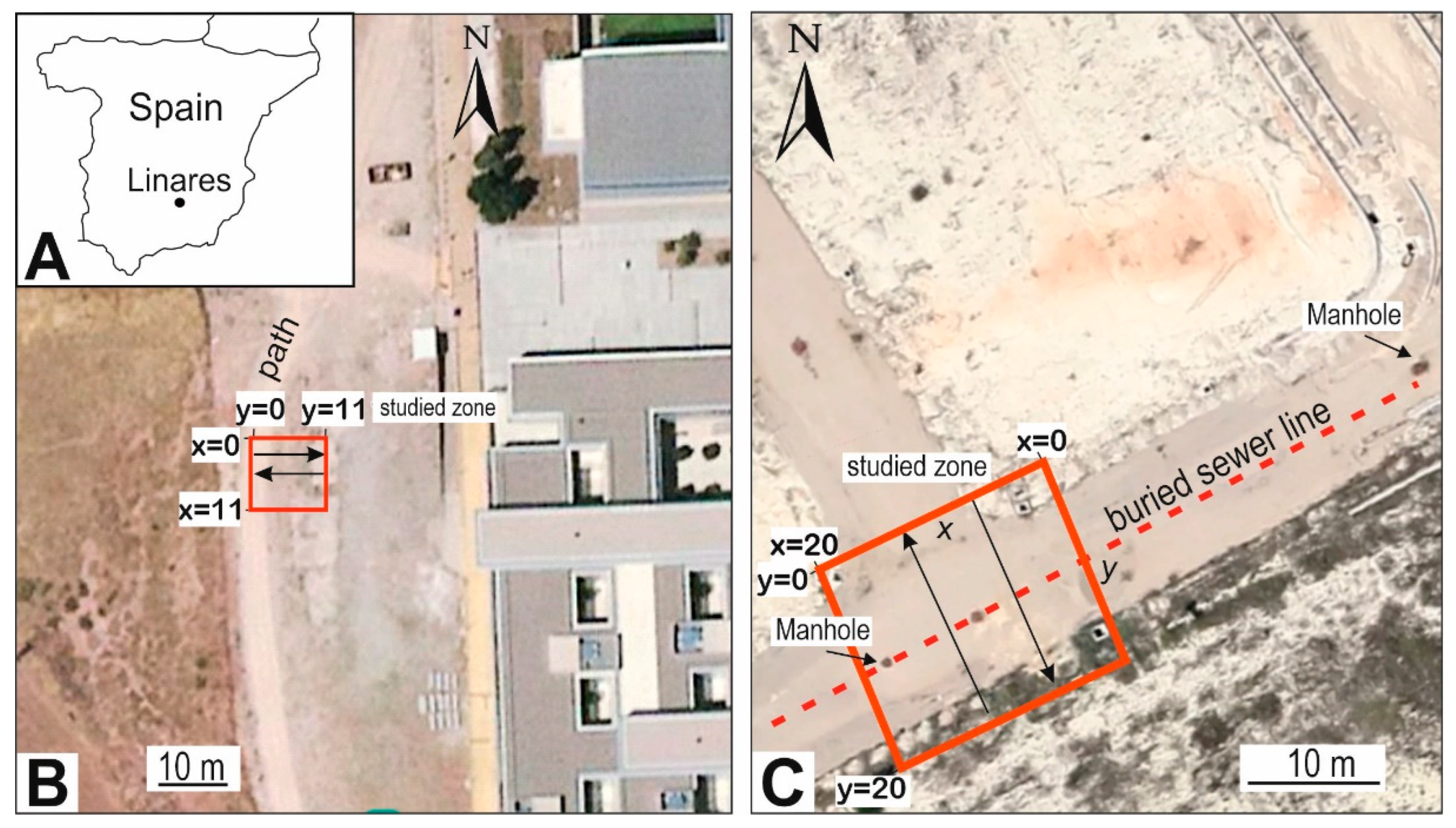
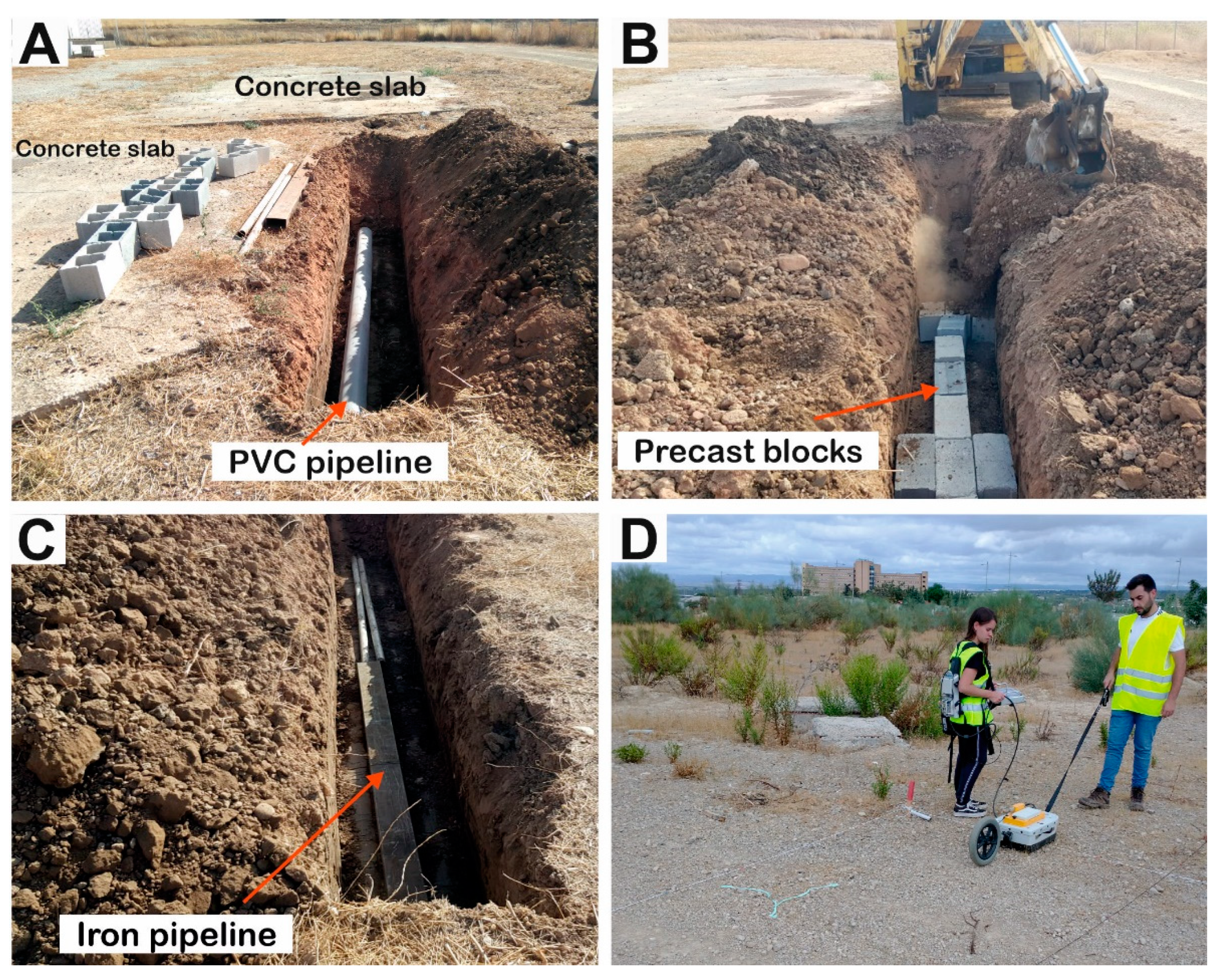
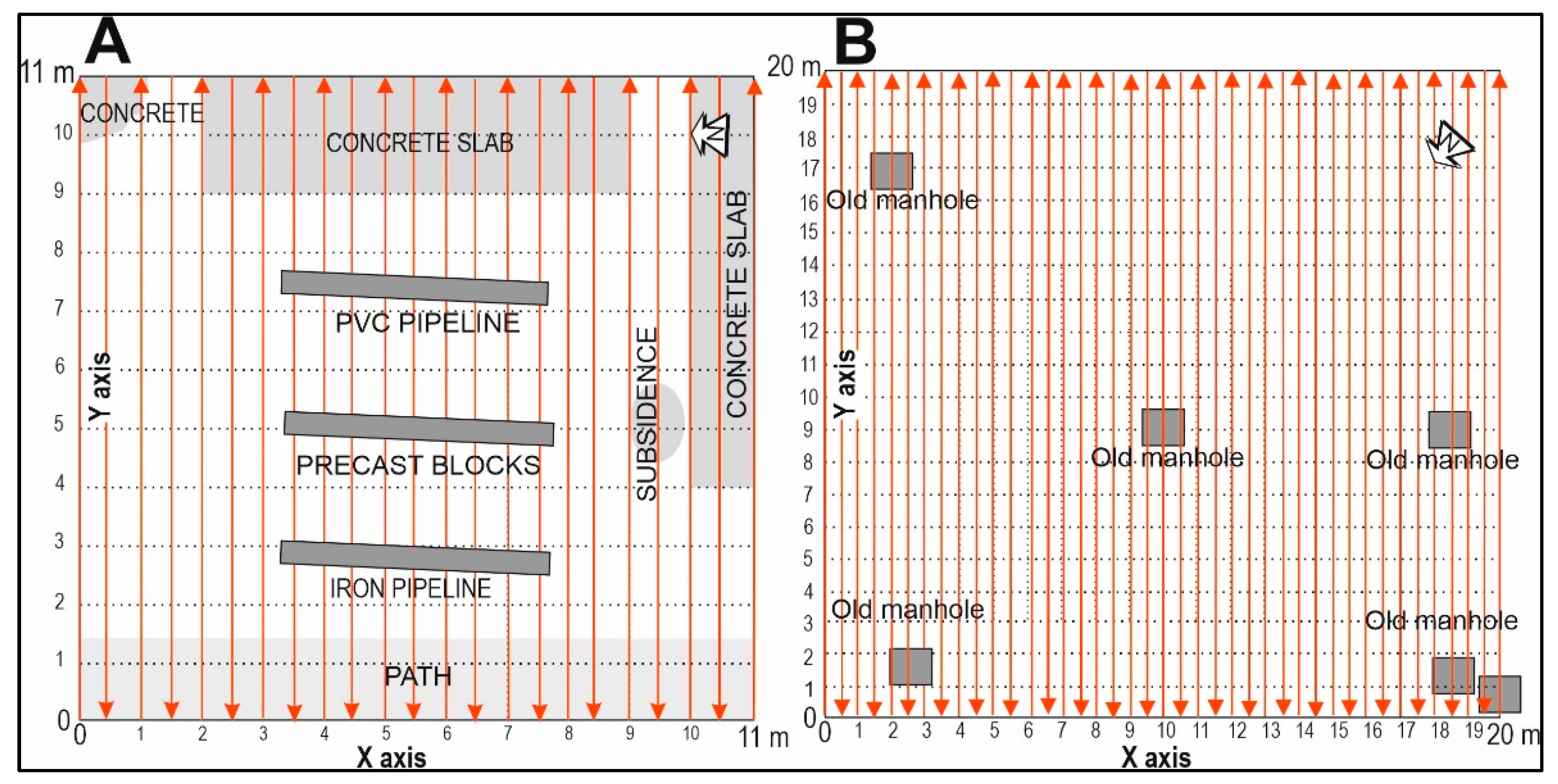

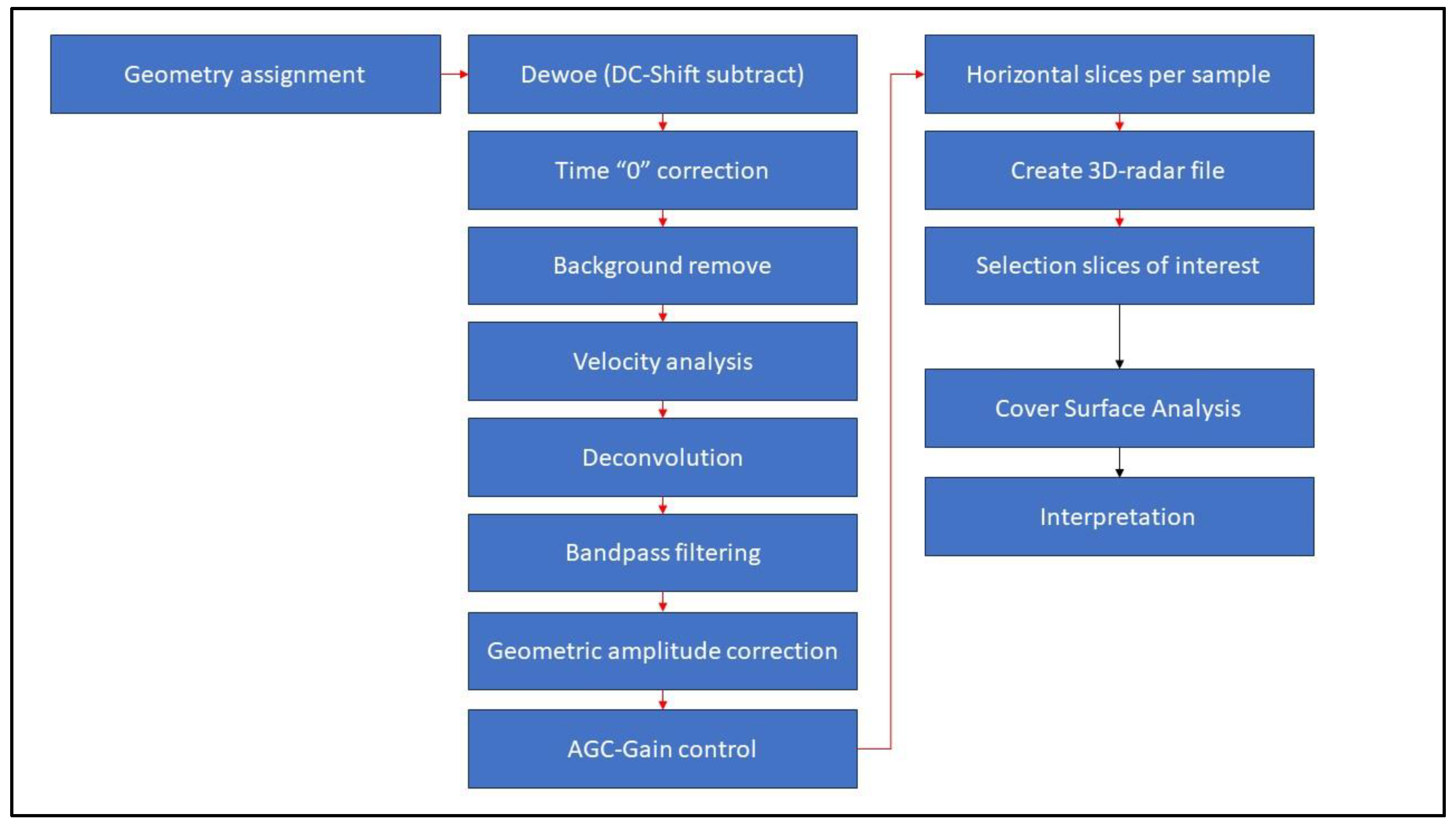

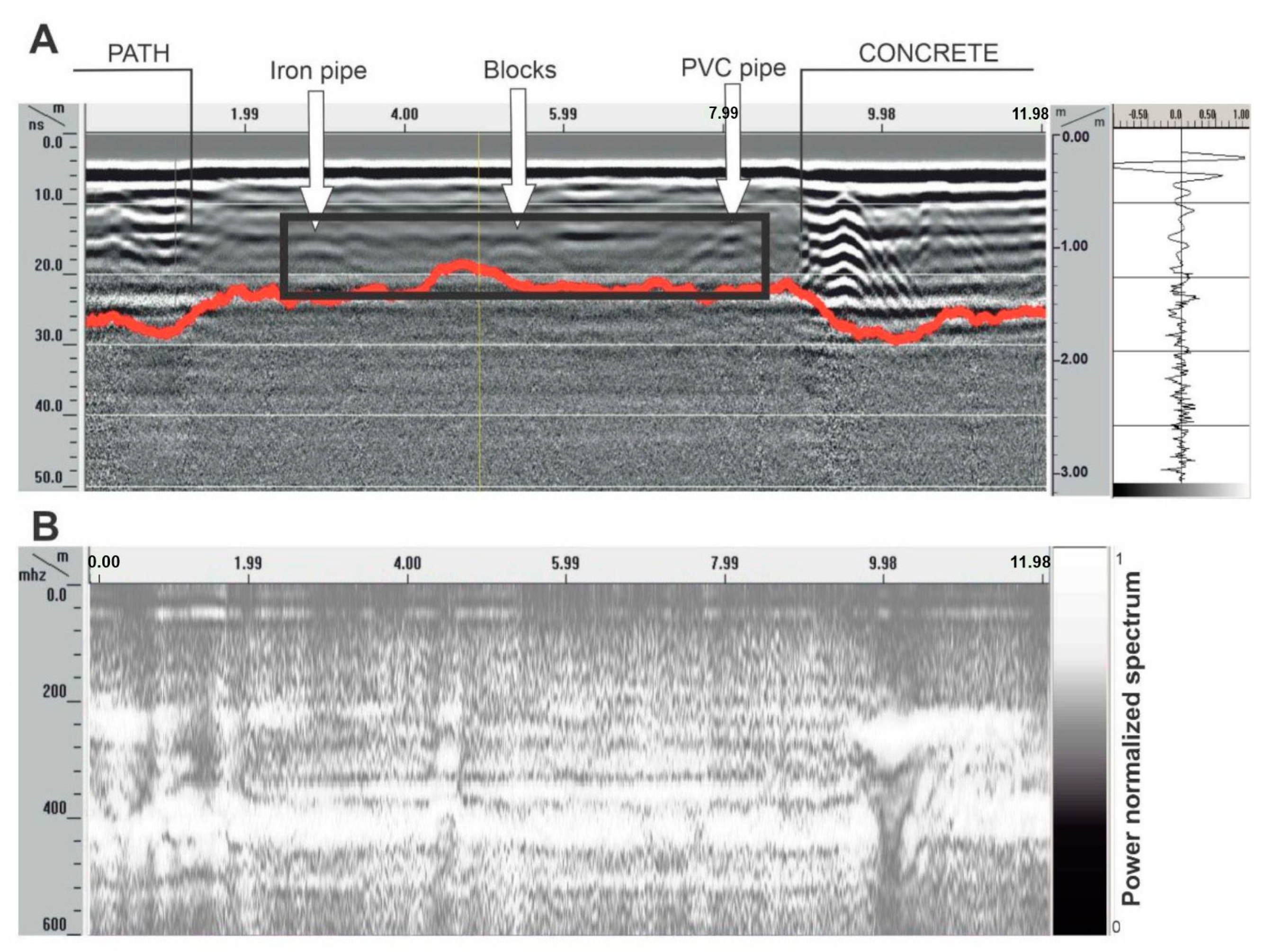
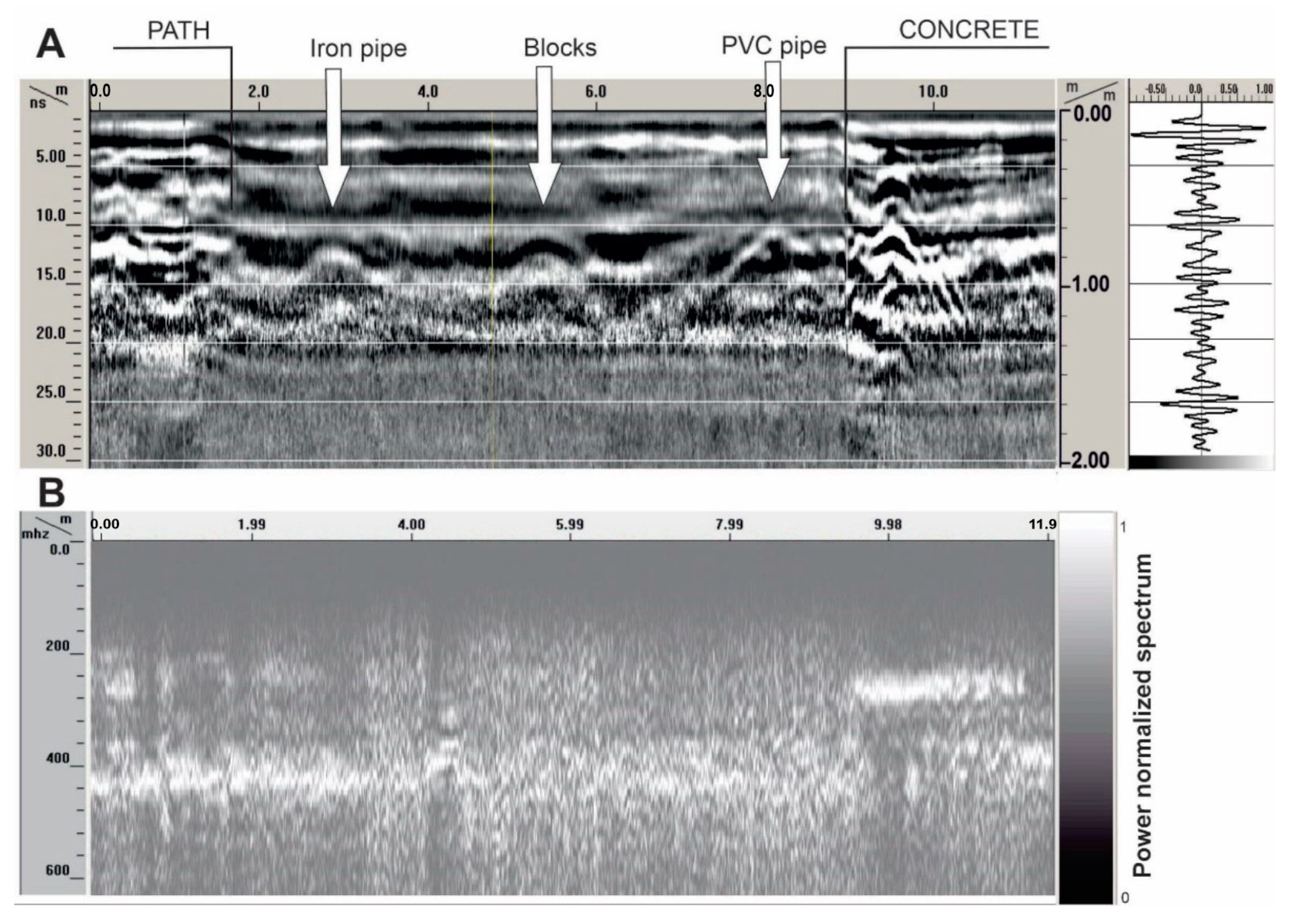

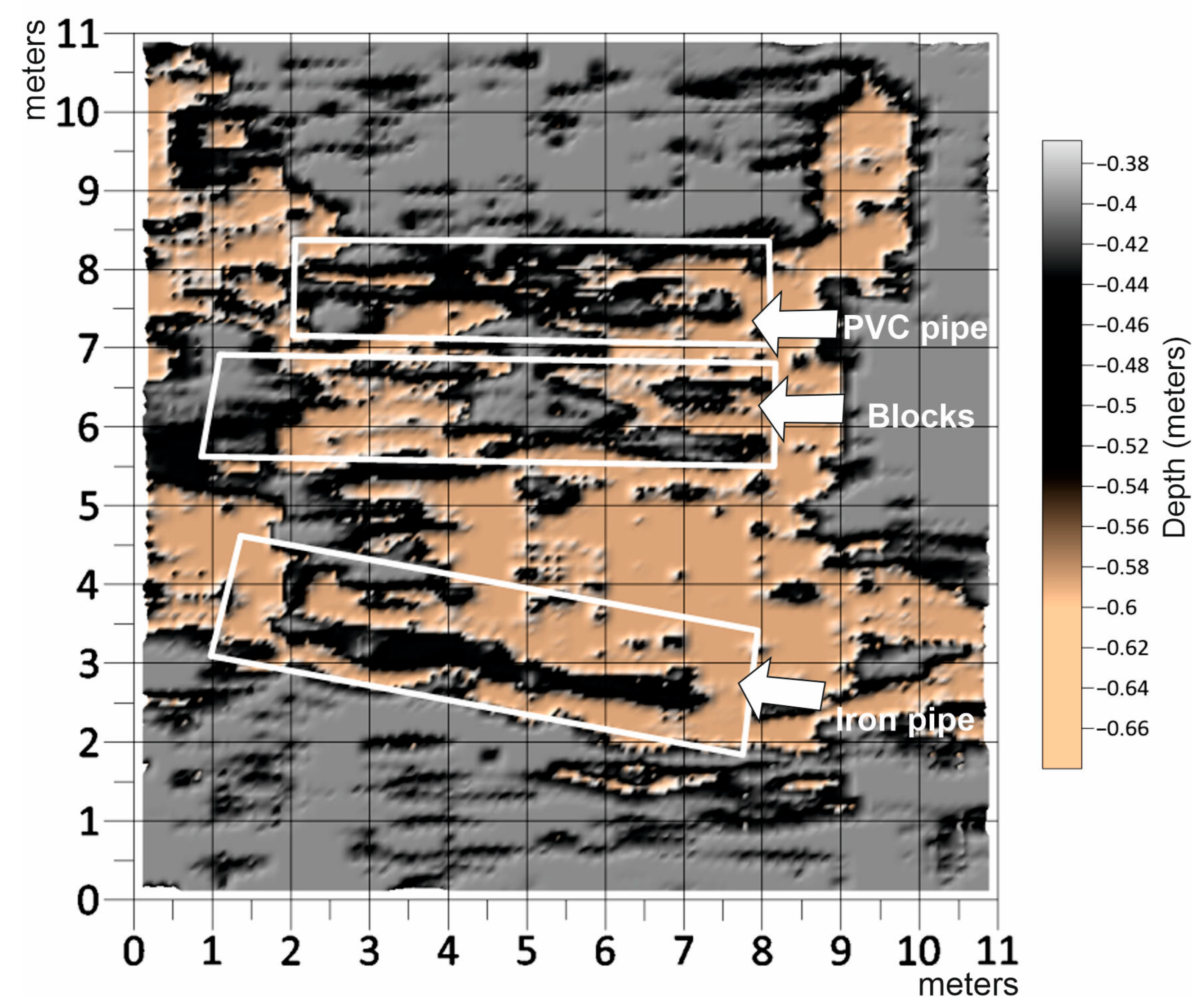
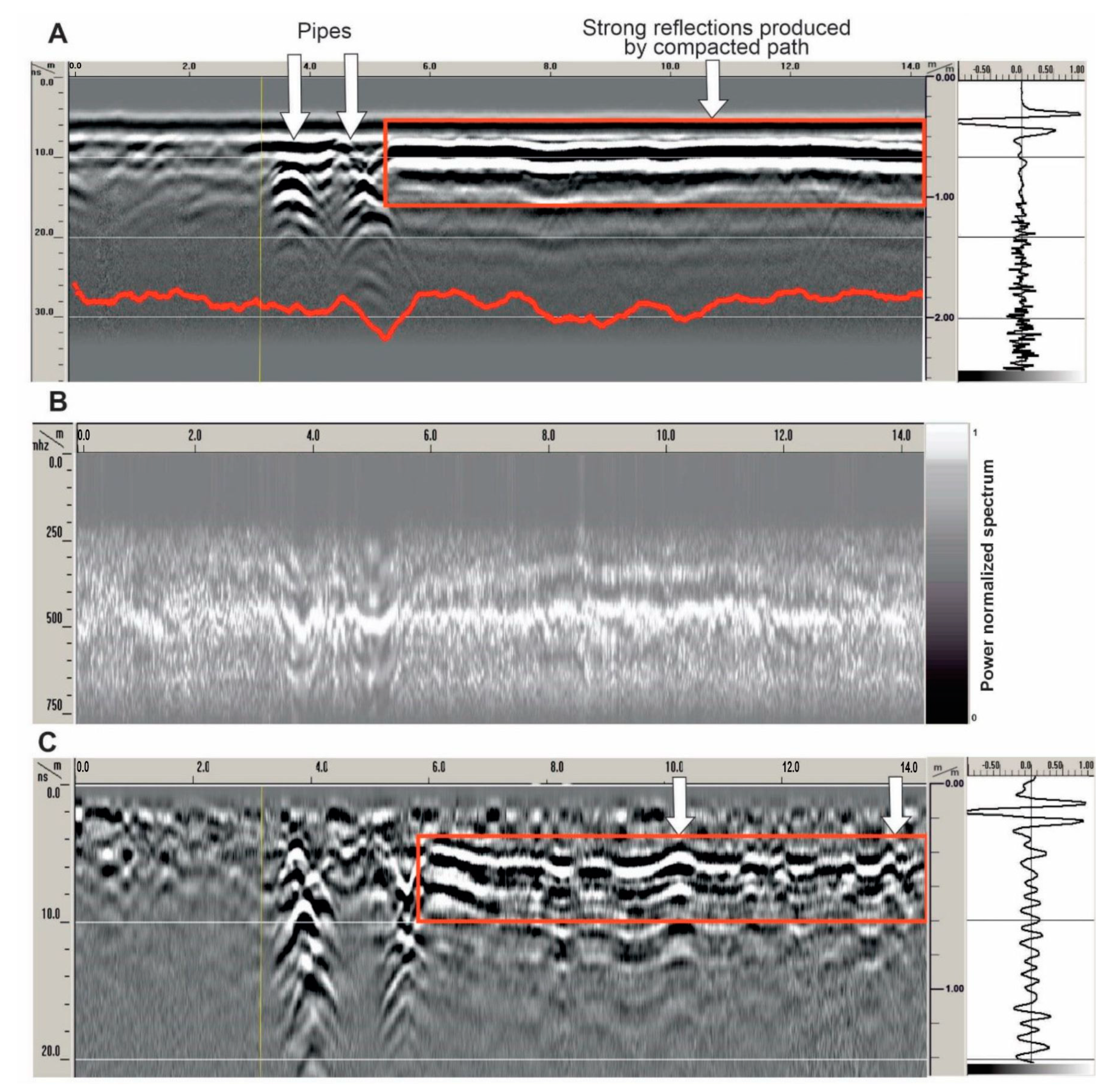
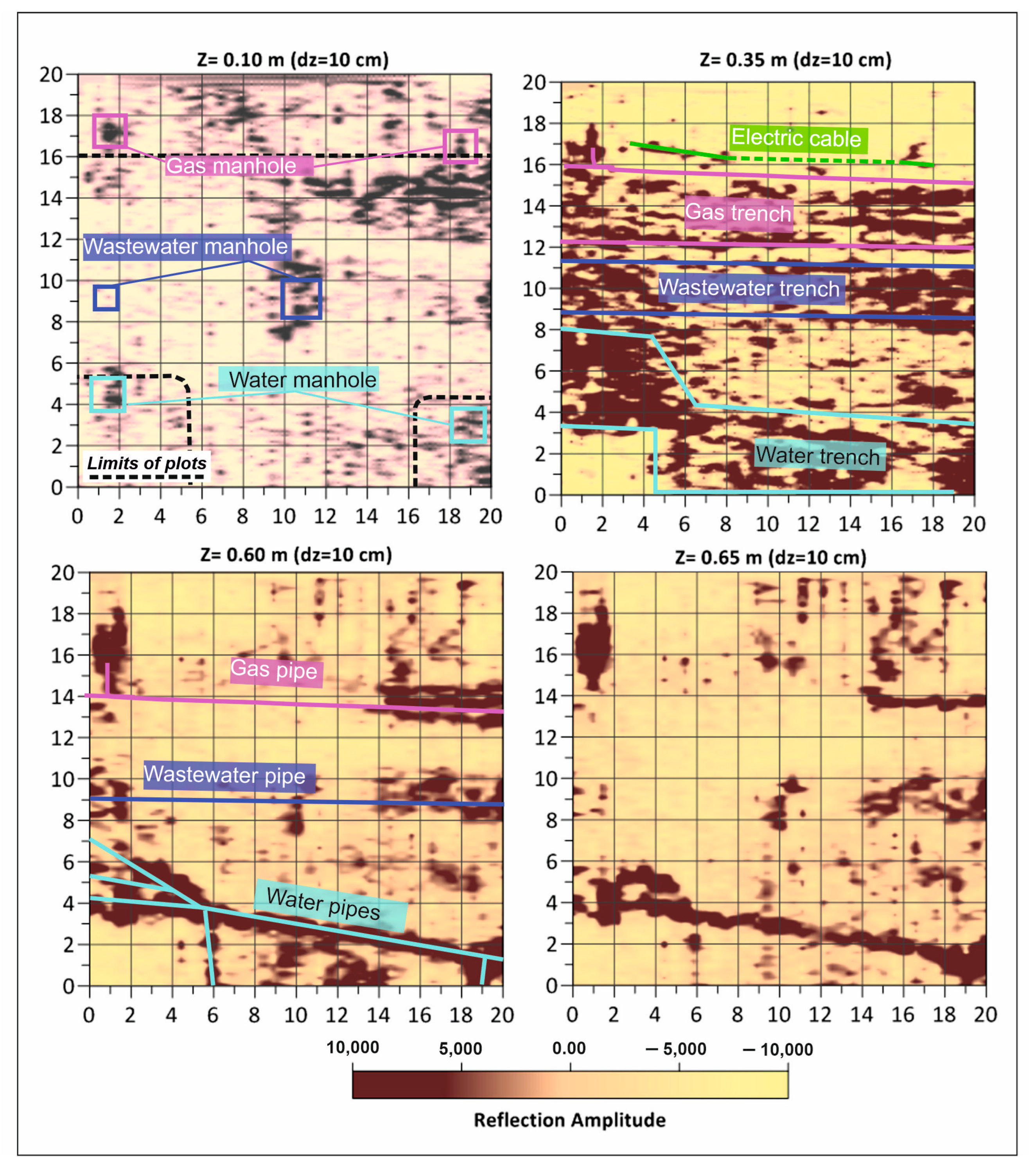

| Main GPR Acquisition Parameters | ||
|---|---|---|
| Parameters | Site 1 | Site 2 |
| Profile spacing | 0.5 m | 0.5 m |
| Number of profiles | 23 | 41 |
| Trace spacing | 0.01 m | 0.01 m |
| Time window | 30 ns | 40 ns |
| Samples trace | 248 | 312 |
| Steps | Description |
|---|---|
| Subtract DC shift | To eliminate the residual voltage |
| Static correction | To adjust the delay time at time = 0 ns |
| Remove the background noise | To eliminate the multiples proceed by coupled wave (air-surface) |
| Spiking predictive deconvolution | To eliminate additional multiples caused by other superficial structures and increase the high-frequency content; Operator length of 21 ns, predication lag of 7 ns, pre-whitening 10% |
| Bandpass filter | 50 MHz–550 MHz to eliminate the high and low noise frequencies |
| Geometric amplitude correction | To restitute the amplitude content for wave front propagation |
| Gain control (GC) | To increase the amplitude between 10–30 ns where the buried structures are placed; a gain function was created by modifying the AGC |
Disclaimer/Publisher’s Note: The statements, opinions and data contained in all publications are solely those of the individual author(s) and contributor(s) and not of MDPI and/or the editor(s). MDPI and/or the editor(s) disclaim responsibility for any injury to people or property resulting from any ideas, methods, instructions or products referred to in the content. |
© 2023 by the authors. Licensee MDPI, Basel, Switzerland. This article is an open access article distributed under the terms and conditions of the Creative Commons Attribution (CC BY) license (https://creativecommons.org/licenses/by/4.0/).
Share and Cite
Mendoza, R.; Araque-Perez, C.; Marinho, B.; Rey, J.; Hidalgo, M.C. Processing GPR Surveys in Civil Engineering to Locate Buried Structures in Highly Conductive Subsoils. Remote Sens. 2023, 15, 4019. https://doi.org/10.3390/rs15164019
Mendoza R, Araque-Perez C, Marinho B, Rey J, Hidalgo MC. Processing GPR Surveys in Civil Engineering to Locate Buried Structures in Highly Conductive Subsoils. Remote Sensing. 2023; 15(16):4019. https://doi.org/10.3390/rs15164019
Chicago/Turabian StyleMendoza, Rosendo, Carlos Araque-Perez, Bruna Marinho, Javier Rey, and Mari Carmen Hidalgo. 2023. "Processing GPR Surveys in Civil Engineering to Locate Buried Structures in Highly Conductive Subsoils" Remote Sensing 15, no. 16: 4019. https://doi.org/10.3390/rs15164019
APA StyleMendoza, R., Araque-Perez, C., Marinho, B., Rey, J., & Hidalgo, M. C. (2023). Processing GPR Surveys in Civil Engineering to Locate Buried Structures in Highly Conductive Subsoils. Remote Sensing, 15(16), 4019. https://doi.org/10.3390/rs15164019









